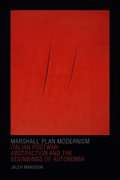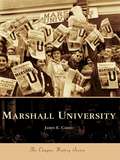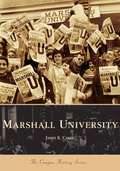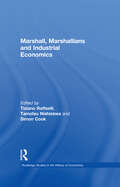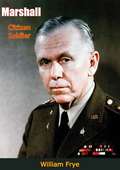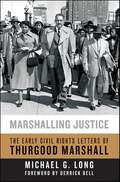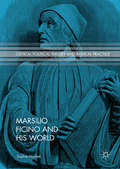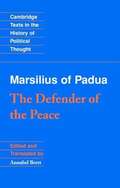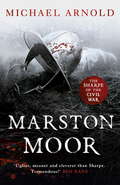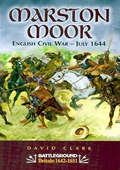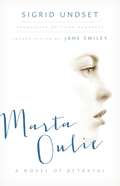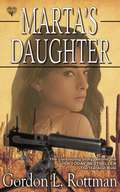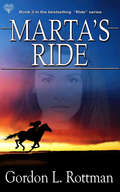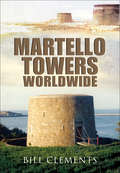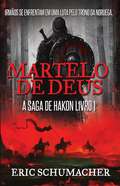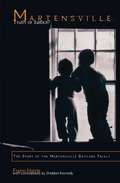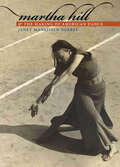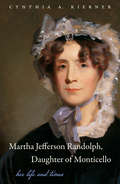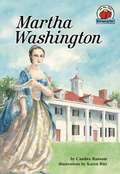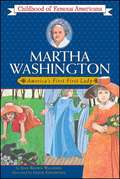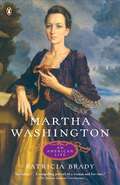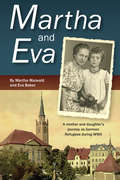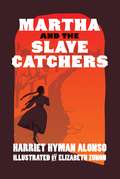- Table View
- List View
Marshall Plan Modernism: Italian Postwar Abstraction and the Beginnings of Autonomia
by Jaleh MansoorFocusing on artwork by Lucio Fontana, Alberto Burri, and Piero Manzoni, Jaleh Mansoor demonstrates and reveals how abstract painting, especially the monochrome, broke with fascist-associated futurism and functioned as an index of social transition in postwar Italy. Mansoor refuses to read the singularly striking formal and procedural violence of Fontana's slit canvasses, Burri's burnt and exploded plastics, and Manzoni's "achromes" as metaphors of traumatic memories of World War II. Rather, she locates the motivation for this violence in the history of the medium of painting and in the economic history of postwar Italy. Reconfiguring the relationship between politics and aesthetics, Mansoor illuminates how the monochrome's reemergence reflected Fontana, Burri, and Manzoni's aesthetic and political critique of the Marshall Plan's economic warfare and growing American hegemony. It also anticipated the struggles in Italy's factories, classrooms, and streets that gave rise to Autonomia in the 1960s. Marshall Plan Modernism refigures our understanding of modernist painting as a project about labor and the geopolitics of postwar reconstruction during the Italian Miracle.
Marshall University (Campus History)
by James E. CastoIn 1837, the people of Guyandotte, then a village on the Virginia frontier, resolved to open a school for their sons and daughters. Tradition says local lawyer John Laidley convinced his neighbors to name the school for his friend, Chief Justice John Marshall. The one-room log cabin that housed those first students soon gave way to a two-story brick building that, with various additions over the years, became the school's Old Main. For decades, the cherished landmark has stood like a proud sentinel, watching Marshall grow and evolve into a major university with an enrollment over 16,000. This remarkable volume, with more than 200 historic photographs from the Marshall archives, chronicles the dramatic Marshall saga.
Marshall University (The Campus History Series)
by James E. CastoIn 1837, the people of Guyandotte, then a village on the Virginia frontier, resolved to open a school for their sons and daughters. Tradition says local lawyer John Laidley convinced his neighbors to name the school for his friend, Chief Justice John Marshall. The one-room log cabin that housed those first students soon gave way to a two-story brick building that, with various additions over the years, became the school's Old Main. For decades, the cherished landmark has stood like a proud sentinel, watching Marshall grow and evolve into a major university with an enrollment over 16,000. This remarkable volume, with more than 200 historic photographs from the Marshall archives, chronicles the dramatic Marshall saga.
Marshall, Marshallians and Industrial Economics (Routledge Studies In The History Of Economics Ser.)
by Tiziano Raffaelli Tamotsu Nishizawa Simon CookThe four sections of the book deal in succession with Marshall’s key ideas on the subject, the wider context of his thought in which they are to be read, their later development by some of his pupils, and their revival in contemporary economics. The first and last sections work together to illustrate the evolutionary focus of Marshall’s research program and to identify its affinity with modern industrial economics; the second explicates the social assumptions within which the Marshallian paradigm was embedded, in particular those relating to the various relationships that exist between individuals and wider groups; while the third traces the development of Marshall’s views by some of his pupils.
Marshall: Citizen Soldier
by William FryeIf you think of biography as the static record of a man’s achievement, compiled during twenty or more mellowing years, William Frye’s book will have the impact of an electric shock. Marshall: Citizen Soldier is not to be leafed through idly, just as George Catlett Marshall himself cannot be regarded passively.That deceptively mild manner of his, as buck privates, brass hats and not a few politicos have discovered, only indifferently conceals a driving determination, backed by an inner steel core of moral integrity and joined with a lifetime’s habit of command.The general public has not given Marshall the excited, short-lived adulation that it has heaped upon more flamboyantly dramatic military men. But the people recognized in George Marshall the citizen’s soldier to whom they could safely entrust the most vital post in an America at war—Chief of Staff of the United States Army.The acceptance by Marshall early in 1947 of one of the greatest appointive offices in our government, that of Secretary of State, a job today of world significance, leaves no doubt either of the abilities of the man or of his devotion to the public weal. For the dearest wish of the erstwhile Chief of Staff had been a quiet retirement at the end of his Army duties.Marshall began his career in unorthodox fashion by graduating from the V.M.I. instead of West Point. Even on routine tours of duty in the Philippines, in the States and later in China he was singled out by senior officers as a young man of remarkable ability. During World War I, Marshall asked for command duty in France. His superiors rushed him abroad but they realized that Major Marshall was hard-to-get staff officer material, not slated for a regular front-line assignment.William Frye as Marshall’s biographer comes into touch with some of the knottiest questions of the war years. He does not sidestep issues and controversies; he meets them with decision.
Marshalling Justice: The Early Civil Rights Letters of Thurgood Marshall
by Michael G. Long“[An] important collection….Michael G. Long deserves high praise indeed for unearthing [Marshall’s letters] and bringing them to light.”—Wil HaygoodCollected together for the first time in Marshalling Justice, here are selected letters written by one of the most influential and important activists in the American Civil Rights movement: the brilliant legal mind and footsoldier for justice and racial equality, Thurgood Marshall. The correspondences of a rebellious young attorney with the National Association for the Advancement of Colored People (NAACP), Marshalling Justice paints an eye-opening portrait of Thurgood Marshall before he became the first African American to serve on the U.S. Supreme Court, during his years as a groundbreaking and vibrant Civil Rights activist in the tradition of Martin Luther King and Julian Bond.
Marsilio Ficino and His World
by Sophia HowlettThis book makes the case for Marsilio Ficino, a Renaissance philosopher and priest, as a canonical thinker, and provides an introduction for a broad audience. Sophia Howlett examines him as part of the milieu of Renaissance Florence, part of a history of Platonic philosophy, and as a key figure in the ongoing crisis between classical revivalism and Christian belief. The author discusses Ficino's vision of a Platonic Christian universe with multiple worlds inhabited by angels, daemons and pagan gods, as well as our own distinctive role within that universe - climbing the heights to talk with angels yet constantly confused by the evidence of our own senses. Ficino as the "new Socrates" suggests to us that by changing ourselves, we can change our world.
Marsilius of Padua at the Intersection of Ancient and Medieval Traditions of Political Thought
by Vaileios SyrosThis book focuses on the reception of classical political ideas in the political thought of the fourteenth-century Italian writer Marsilius of Padua. Vasileios Syros provides a novel cross-cultural perspective on Marsilius's theory and breaks fresh ground by exploring linkages between his ideas and the medieval Muslim, Jewish, and Byzantine traditions.Syros investigates Marsilius's application of medical metaphors in his discussion of the causes of civil strife and the desirable political organization. He also demonstrates how Marsilius's demarcation between ethics and politics and his use of examples from Greek mythology foreshadow early modern political debates (involving such prominent political authors as Niccolò Machiavelli and Paolo Sarpi) about the political dimension of religion, church-state relations, and the emergence and decline of the state.
Marsilius of Padua: The Defender of the Peace
by Annabel Brett'The Defender of the Peace of Marsilius of Padua' is a massively influential text in the history of western political thought. Marsilius offers a detailed analysis and explanation of human political communities, before going on to attack what he sees as the obstacles to peaceful human coexistence.
Marston Moor: Book 6 of The Civil War Chronicles (Stryker)
by Michael ArnoldThe Sixth in The Civil War Chronicles featuring Major Stryker - 'the Sharpe of the Civil War'FIVE ARMIES FORTY-SIX THOUSAND MEN ONE CROWNTHE BIGGEST BATTLE OF THE AGE2 July 1644. Five armies converge outside York. It will be a battle for honour, glory, and the fate of three kingdoms. And it will pit two great leaders - Oliver Cromwell and Prince Rupert - directly against one another for the first time. It is a day that will change the course of history.Into the cannon fire and musket smoke marches Major Innocent Stryker, battle-scarred hero of the Royalist cause. He must not only lead his men through the bloody horror and outwit his Parliamentary enemies, but uncover foul treachery on his own side. He will need every shred of experience and determination to survive.Marston Moor will be the decisive turning point in the British Civil Wars.This is the thrilling and shocking story of that battle.
Marston Moor: English Civil War–July 1644 (Battleground Britain 1642–1651)
by David ClarkFollowing on from the success of the first book in this series on the English Civil war, Naseby, here is the story of Marston Moor, arguably the most famous battle in the four year conflict.In this exciting analysis of the battle the Author has captured the atmosphere and made it possible to get the most out of the experience. Marston Moor was an extremely bitter and costly battle and a defeat for the Royalist cause that had major implications for King Charles I. One result was that the key city of York was lost thereby seriously weakening the King's grip on the North.
Marta Oulie: A Novel of Betrayal
by Sigrid Undset&“I have been unfaithful to my husband.&” Marta Oulie&’s opening line scandalized Norwegian readers in 1907. And yet, Sigrid Undset had a gift for depicting modern women &“sympathetically but with merciless truthfulness,&” as the Swedish Academy noted in awarding her the Nobel Prize for Literature in 1928. At the time she was one of the youngest recipients and only the third woman so honored. It was Undset&’s honest story of a young woman&’s love life—&“the immoral kind,&” as she herself bluntly put it—that made her first novel an instant sensation in Norway.Marta Oulie, written in the form of a diary, intimately documents the inner life of a young woman disappointed and constrained by the conventions of marriage as she longs for an all-consuming passion. Set in Kristiania (now Oslo) at the beginning of the twentieth century, Undset&’s book is an incomparable psychological portrait of a woman whose destiny is defined by the changing mores of her day—as she descends, inevitably, into an ever-darker reckoning. Remarkably, though Undset&’s other works have attracted generations of readers, Marta Oulie has never before appeared in English translation. Tiina Nunnally, whose award-winning translation of Undset&’s Kristin Lavransdatter captured the author&’s beautifully clear style, conveys the voice of Marta Oulie with all the stark poignancy of the original Norwegian.
Marta's Daughter (Ride #4)
by Gordon L. RottmanArsenia Renee Eugen is the seventeen-year-old daughter of the living legends, Bud and Marta Eugen. While ranch-raised and as capable as any vaquero, she was educated at the St. Joseph Academy in Eagle Pass, Texas. She holds down a dull job as a bookkeeper and assistant manager of the Flint Hotel. Shopping in Piedras Negras across the Rio Grande she was conned by twenty-one-year-old Yaqui Ana Mendoza Gomez. Swearing vengeance, she sought out the young woman and unexpectedly rescued her from gringos bent on revenge after Yaqui Ana had conned them. Not expecting to see Yaqui Ana again, Arsenia received a note that the woman had been forced into prostitution. Again rescuing her, they find themselves taking over a notorious cantina and cathouse, where they fall into a world of gamblers, drinkers, conmen, smugglers, gun runners, banditos, treacherous militiamen, spies, and traitors.
Marta's Ride (Ride #3)
by Gordon L. RottmanA USA TODAY and Amazon bestseller, author Gordon L. Rottman has finally given fans of The Hardest Ride and Ride Harder their beloved heroine Marta’s own tale, and in a way, her own voice. The brutal 1886 winter on the Texas-Mexico border is a terrible time for a mute sixteen-year-old Mexican girl and her familia, who roam the trails and towns of the frontier, searching for work and struggling to survive. When her parents and siblings are murdered before her eyes, Marta is faced with a stark reality. Completely alone in the harsh Texas backlands, she realizes her own time in this world will be short, lonely, and possibly end in blood. Marta has not lived and thrived in her hardscrabble life thus far to give up without a fight. And the arrival of an out of work cowboy from whom she grudgingly accepts help and protection gives her a sliver of hope. Besides she reasons, Güero—Blondie—as she’s named him, would be lost without her care, guidance, and decent meals. Despite the chasm between Mexicans and Anglos in this harsh age, the loner cowpoke and mute Mexican girl tentatively build a fragile trust. Finding work on a welcoming ranch, the couple bonds, and their future appears brighter. But a raid by vicious bandits takes Marta, another Mexican girl, and the rancher’s two daughters on a journey into hell. Marta tells us a harrowing tale of terror and anguish as the women struggle to stay alive and hang on to their sanity. Her faith in Güero coming to their rescue rises and diminishes day-to-day as their circumstances change. In the end, there is a great deal more to Marta than we ever realized.
Martello Towers Worldwide
by Bill ClementsMartello Towers Worldwide follows the history of the Martello tower from the construction of the early towers built to protect the Mediterranean shores of Spain and Italy right up to the final towers built in the United Kingdom during the First World War.The book is illustrated with a large number of contemporary and historic photographs, drawings and plans, a very large number of which were not included in the earlier Towers of Strength. These provide the most detailed information yet published about the development of the Martello towers in Britain and overseas. So the book will be of particular interest to those interested in the history of fortifications, architectural conservation and military history generally. It will also be of interest to an international readership as the book now has a gazetteer of towers outside the United Kingdom that remain today together with a chapter describing a number of towers built in the United States.The book supplements the earlier Towers of Strength and such will be an important addition to the existing bibliography of books on Martello towers and fortification.
Martelo de Deus
by Eric SchumacherA história e a lenda se confundem no emocionante conto sobre a vida de Hakon Haraldsson, um menino cristão que lutou pelo Alto Assento de um reino viking. Estamos no ano de 935 d.C. e o norte vives um tempo tumultuado. O rei Harald Fairhair morreu, deixando o Alto Assento do seu reino para o seu filho assassino, Erik Bloodaxe. Para garantir a sua ascensão, Erik impiedosamente elimina todos os pretendentes ao seu trono, exceto um: o seu irmão mais novo, Hakon. Os inimigos sobreviventes de Erik enviam um navio para Wessex, onde o rei cristão Athelstan está criando Hakon. Incapaz de fugir de seu destino, Hakon retorna ao Norte Viking para enfrentar o seu irmão e reivindicar o seu direito de primogenitura, mas ele vai descobrir que a vitória exigirá sacrifícios além de seus pesadelos mais selvagens.
Martensville: The Story of the Martensville Daycare Trials
by Frann HarrisWhen a child-abuse scandal is uncovered at an unlicenced daycare in small-town Saskatchewan, it polarizes the community. Frann Harris, a rookie court reporter assigned to the trial the longest in Saskatchewan history starts to wonder if the scope of the alleged crimes is dwarfed by something even more startling: a botched police investigation and inappropriate courtroom procedures.Harris’ narrative alternates between the stories of child sexual abuse and whimsical recollections of her own childhood, using the odd touch of humour. Because the unfamiliar courtroom jargon sounds like a foreign language to her and to most readers, she translates it into plain English, and simplifies and demystifies elaborate and stylized courtroom procedures.Harris takes the reader into the courtroom, recreating the trial in all its complexities: the painful allegations of the children and their parents; the daily parry-and-thrust of lawyers trying to discredit both the police investigation and the testimony of the victims; and the contradictory testimony of psychologists and medical experts. Harris also goes outside the courtroom, interviewing witnesses and eavesdropping on the conversations of the accused, the police, neighbours and journalists.The verdicts in the Martensville case were and still are hotly contested. We may never know what really happened at the daycare, but in Martensville: Truth or Justice? The Story of the Martensville Daycare Trials, we can learn the intricacies of the investigation and the trial, and decide for ourselves whether justice was served.
Martha Hill and the Making of American Dance
by Janet Mansfield SoaresA lively and intimate portrait of an unsung heroine in American dance Martha Hill (1900–1995) was one of the most influential figures of twentieth century American dance. Her vision and leadership helped to establish dance as a serious area of study at the university level and solidify its position as a legitimate art form. Setting Hill's story in the context of American postwar culture and women's changing status, this riveting biography shows us how Hill led her colleagues in the development of American contemporary dance from the Kellogg School of Physical Education to Bennington College and the American Dance Festival to the Juilliard School at Lincoln Center. She created pivotal opportunities for Martha Graham, Doris Humphrey, Charles Weidman, Hanya Holm, José Limón, Merce Cunningham, and many others. The book provides an intimate look at the struggles and achievements of a woman dedicated to taking dance out of the college gymnasium and into the theatre, drawing on primary sources that were previously unavailable. It is lavishly illustrated with period photographs.
Martha Jefferson Randolph, Daughter of Monticello
by Cynthia A. KiernerAs the oldest and favorite daughter of Thomas Jefferson, Martha "Patsy" Jefferson Randolph (1772-1836) was extremely well educated, traveled in the circles of presidents and aristocrats, and was known on two continents for her particular grace and sincerity. Yet, as mistress of a large household, she was not spared the tedium, frustration, and great sorrow that most women of her time faced. Though Patsy's name is familiar because of her famous father, Cynthia Kierner is the first historian to place Patsy at the center of her own story, taking readers into the largely ignored private spaces of the founding era. Randolph's life story reveals the privileges and limits of celebrity and shows that women were able to venture beyond their domestic roles in surprising ways.Following her mother's death, Patsy lived in Paris with her father and later served as hostess at the President's House and at Monticello. Her marriage to Thomas Mann Randolph, a member of Congress and governor of Virginia, was often troubled. She and her eleven children lived mostly at Monticello, greeting famous guests and debating issues ranging from a woman's place to slavery, religion, and democracy. And later, after her family's financial ruin, Patsy became a fixture in Washington society during Andrew Jackson's presidency. In this extraordinary biography, Kierner offers a unique look at American history from the perspective of this intelligent, tactfully assertive woman.
Martha Peake
by Patrick McgrathMaster storyteller Patrick McGrath--author of the critically acclaimed novel Asylum and a finalist for England's prestigious Whitbread Prize for fiction--once again spins a hypnotic tale of psychological suspense and haunting beauty. Set among the teeming streets and desolate wharves of Hogarth's London, then shifting to the powder-keg colony of Massachusetts Bay, Martha Peake envelops the reader in a world on the brink of revolution, and introduces us to a flame-haired heroine who will live in the imagination long after the last page is turned.Settled with our narrator beside a crackling fire, we hear of the poet and smuggler Harry Peake--how Harry lost his wife, Grace, in a tragic fire that left him horribly disfigured; how he made a living displaying his deformed spine in the alehouses of eighteenth-century London; and how his only solace was his devoted daughter, Martha, who inherited all of his fire but none of his passion for cheap gin. As the drink eats away at Harry's soul, it opens ancient wounds; when he commits one final act of unspeakable brutality, Martha, fearing for her life, must flee for the American colonies. Once safely on America's shores, Martha immerses herself in the passions of smoldering rebellion. But even in this land of new beginnings, she is unable to escape the past. Caught up in a web of betrayals, she redeems herself with one final, unforgettable act of courage.Superbly plotted and wholly absorbing, Martha Peake is an edge-of-your-seat shocker that is crafted with the psychological precision Patrick McGrath's fans have come to expect. A writer whose novels The New York Times Book Review has called both "mesmerizing" and "brilliant," McGrath applies his remarkable imaginative powers to a fresh and broad historical canvas. Martha Peake is the poignant, often disturbing tale of a child fighting free of a father's twisted love, and of the colonists' struggle to free themselves from a smothering homeland. It is Patrick McGrath's finest novel yet.From the Hardcover edition.
Martha Washington ((On my own biography))
by Candice RansomMartha Dandridge Custis was twenty-seven years old when she married George Washington. She worked by her husband's side to help keep their family, home, and country running smoothly. Whether she was at a ball or on a battlefield, Martha Washington set the standard for all future First Ladies with her quiet determination and courage.
Martha Washington: America's First First Lady (Childhood of Famous Americans)
by Jean Brown WagonerDid you know that Martha Washington was called Patsy when she was a little girl? Or, that she loved horses? She even had a pet baby black bear. This short biography covers the future first "First Lady's" childhood and teen years, with some details in a final chapter on her later years, in an easy-to-read and interesting narrative for middle-schoolers and young teens.
Martha Washington: An American Life
by Patricia BradyWith this revelatory and painstakingly researched book, Martha Washington, the invisible woman of American history, at last gets the biography she deserves. In place of the domestic frump of popular imagination, Patricia Brady resurrects the wealthy, attractive, and vivacious young widow who captivated the youthful George Washington. Here are the able landowner, the indomitable patriot (who faithfully joined her husband each winter at Valley Forge), and the shrewd diplomat and emotional mainstay. And even as it brings Martha Washington into sharper and more accurate focus, this sterling life sheds light on her marriage, her society, and the precedents she established for future First Ladies. .
Martha and Eva: A Mother and Daughter's Journey as German Refugees During WWII
by Baker EvaMartha and Eva is a heartfelt and vivid story, weaving together the memories and experiences of a mother and daughter. Their voices recall the treatment put upon them and document their life before and after WWII. You will hear of the wonderful life they had in Schlesien (now Poland) and the fear and deprivation that they experienced - when they became German refugees. More than 3.1 million refugees were mass transported out of Schlesien and into Germany, and more than 400,000 lost their lives during this expulsion. In 1990 Martha died leaving her memoir for her daughter Eva. It was written in the old German (pre-Hitler) script, translated into German, and then ultimately translated into English by her daughter. Eva, only 10 when WWII ended, added her memories to Martha's. They recall their personal struggles and hardships as German refugees -- being ripped from their beloved country, Schlesien.
Martha and the Slave Catchers
by Harriet Hyman AlonsoThirteen-year-old Martha Bartlett insists on being a part of the Underground Railroad rescue to bring her brother Jake back home to their abolitionist community in Connecticut. It's 1860 and though African-Americans and mixed-race peoples in the north are supposed to be free, seven-year-old Jake, the orphan of a fugitive slave, is kidnapped by his "owner" and taken south to Maryland. Jake is what we'd now describe as on the autism spectrum, and Martha knows just how reassure him when he's anxious or fearful. Using aliases, disguises, and other subterfuges, Martha artfully dodges Will and Tom, the slave catchers, but struggles to rectify her new reality with her parents' admonition to always tell the truth. She must be brave but not reckless, clever but not dishonest. But being perceived sometimes as white, sometimes as black during the perilous journey has thrown her sense of her own identity into turmoil. Alonso combines fiction and historical fact to weave a suspenseful story of courage, hope and self-discovery in the aftermath of the Fugitive Slave Act of 1850, while illuminating the bravery of abolitionists who fought against slavery.
